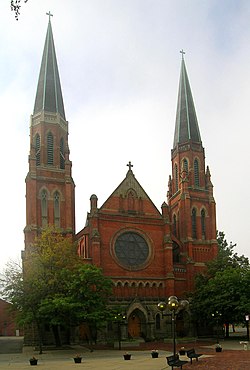
If you have any roots in Detroit, especially Catholic or French, chances are you have many relatives who were married here.
Here is a history of St Anne's Church in Detroit.
Ste. Anne's church was the first building constructed in Fort Pontchartrain du Détroit, which later developed as the city of Detroit. Cadillac and a party of French colonists arrived at the bank of the Detroit River on July 24, 1701. They began construction of a church on July 26, 1701, the feast day of Saint Anne (sainte Anne). The parish was founded and named by the settlers in honor of the patron of France, Saint Anne, mother of Mary and grandmother of Jesus. Nicholas Constantine del Halle, a Franciscan, and François Vaillant, a Jesuit, were the two priests who accompanied the group. Vaillant returned east to Quebec in the fall.[4][5]
Native Americans set the church on fire in 1703, which destroyed part of the fort including the church, the rectory, and the baptismal records. A new church building was built in 1704. The oldest surviving church records date to this time, with the first record on February 2, 1704 being the baptism of a child born to Cadillac. Father del Halle was kidnapped by local Native Americans, likely the historic Ojibwe of the area. After his release, as he walked back to the fort, he was shot and killed by an Indian. His remains were buried under the altar of Ste. Anne's and have been moved four times since to the succeeding new church buildings.
Father Chérubin Deniau was assigned to the parish and began work on a larger church in 1708. This church was outside the fort's palisade. It was burned in 1714 by settlers during a Fox attack, as they feared it would offer cover to the attackers.
The parish did not have a church building for many years after this. One may have been built by Father Bonaventure Liénard, who was priest here for more than three decades, between 1722-1754. Father Simple Bocquet is known to have begun construction of a new church building in 1755, within a year after he arrived. Bocquet served here for nearly 30 years; in 1763 Detroit passed from French to British rule after the latter's victory in the Seven Years' War. After the American Revolutionary War and establishment of independence, the territory came under United States rule. An Anglican wedding was recorded in the parish records during this period.
Father Gabriel Richard was called to Ste. Anne's in 1796. He helped start the school that eventually developed as the University of Michigan, started primary schools for white boys and girls as well as for Indians, and was elected as a territorial representative to U.S. Congress. He helped initiate a road-building project that connected Detroit and Chicago. He also brought the first printing press to Detroit and started The Observer, the Michigan Territory's first newspaper. After his death in 1832, Father Richard was interred under the altar of Ste. Anne's.
In 1805, most of Detroit, including the church, was destroyed in an accidental fire. A new church building was not begun until 1818 and was not completed until 1828. This church was at a new location outside the grounds of the old fort but still near the Detroit River. In 1833, Ste. Anne's was designated as the cathedral for the new Roman Catholic diocese of Detroit; it served in this role until 1848. That year coadjutor bishop Peter Paul Lefevere moved the bishop's throne to St. Peter's Cathedral, today's Saints Peter and Paul Church. Around that time, the old St-Ann's parish registers. Because of this loss, parish registers are no longer freely and easily accessible to the public. Because they contain precious information about the founders and history of Detroit and Michigan, efforts have been made to get copies into the public domain.
In 1817, many of the remains in the old cemetery were moved to the churchyard of the new Ste. Anne's. In the 1860s, many were moved again to Mount Elliott Cemetery, including the remains of Colonel Jean François Hamtramck. In the 1860s, the 1818 church building was demolished. Furnishings and even the cornerstone were split between the new Ste. Anne's and the new parish of St. Joachim, named after Ste. Anne's husband.
https://en.wikipedia.org/wiki/Ste._Anne_de_Detroit_Catholic_Church
No comments:
Post a Comment